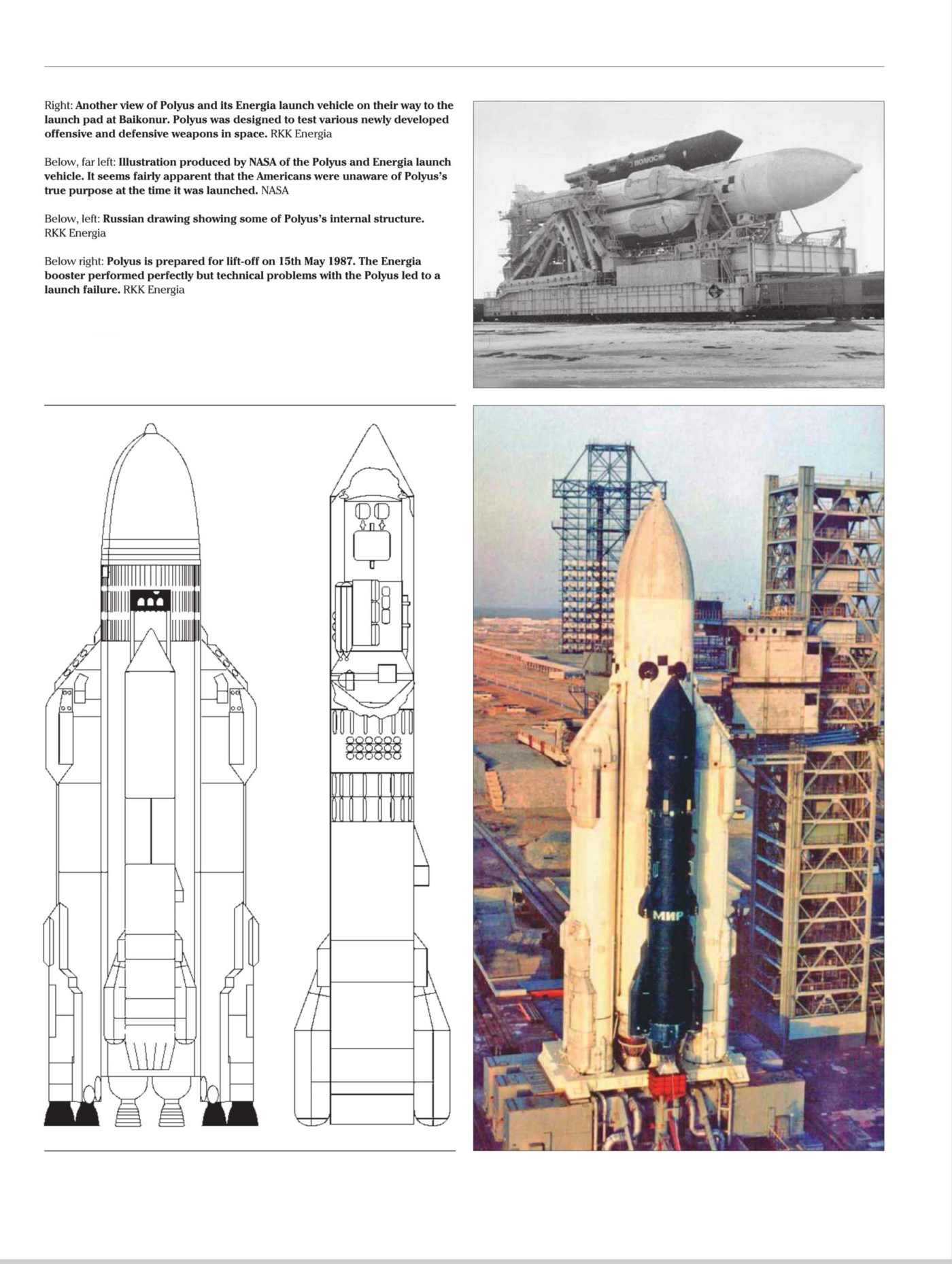
In 1983 President Ronald Reagan announced the development of
a shield in space to protect the United States from nuclear missile attack. The
Strategic Defence Initiative, soon christened Star Wars by the media, was
hugely ambitious, phenomenally expensive and ultimately unworkable, but it
triggered immediate alarm bells in the Kremlin. As a consequence, Chairman Yuri
Andropov authorised the production of systems to match and counter the US
proposals.
One particular design for an experimental orbital combat station was called Polyus (Pole), or Skif-DM, and was designed to test a variety of new technologies. The design originated with Chelomei’s bureau and was based on a TKS-derived module originally intended to serve as the first component for the proposed Mir-2 space station. Normally Soviet space projects were undertaken on a five-year basis, but it seems that Polyus was pushed forward by the leadership who wanted quick results in their quest to keep pace with the Americans.
Andropov died in February 1984 and his successor, Konstantin
Chernenko, continued to support the development of new Soviet space weapons.
However, Chernenko was suffering with emphysema and died the following year, so
it seems probable that others such as Ministers Oleg Dmitriyevich Baklanov and
Oleg Shishkin were shaping events. They had jointly approved the assembly of
Polyus at the Krunichev facility on 1st July 1984 and took overall control of
the project. After Chernenko’s death on 12th March 1985, his successor Mikhail
Gorbachev attempted to halt the development of space weapons, but he also made
it clear to the US administration that the Soviet Union would respond directly
to Reagan’s Star Wars programme if it continued to gain momentum. Gorbachev
believed that the pursuit of space weapons could prove destabilising.
In July 1985 it was agreed to launch a Polyus test vehicle
by September 1986. With the development of the Energia booster moving ahead
quite rapidly, a decision was taken to launch Polyus as part of the first test
flight, although adapting the spacecraft to Energia was proving rather
difficult. The Polyus vehicle was 121ft (37m) in length, it had a diameter of
13ft 4in (4.1 Om) and a mass of 176,369 lb (80,000kg). The intention was to
launch the spacecraft into a 173-mile (280km) orbit with a 64° inclination. The
Polyus spacecraft carried a range of experimental military technologies
designed for offensive and defensive use. Prototype weapons included a cannon
that used a gas exhaust system to counter recoil and a chemical laser, which
probably lacked sufficient power to vaporise targets but certainly had the
ability to destroy optical sensors. A passive optical system was used to aim
both of these systems (which was supported by radar) and a third weapon
described as a nuclear mine dispenser also appears to have required the use of
counter-recoil measures. It was also planned to determine the effectiveness of
releasing barium clouds to diffuse the beams of Directed-Energy Weapons (DEWs)
because this was considered to have good potential as a defensive measure.
Polyus would utilise secure radio data links, but another
technology being tested was laser communication which avoided the possibility
of eavesdropping or jamming. One other experiment involved stealth technology
and the entire vehicle was covered in a matt black radar-absorbing paint.
During the trials personnel on the ground, on ships and aboard aircraft would
attempt to locate and track the spacecraft by visible, infrared and radar
means. If it was detected, they would direct lasers towards Polyus and the beam
would be reflected back to Earth by an onboard mirror. Under considerable
pressure the engineers at NPO Mash completed work on the Polyus prototype and
it was delivered to Baikonur on schedule during August 1986. It had been a
massive effort to override the slow methods of working in the Soviet Union,
compounded by the involvement of several major subcontractors who included NPO
Digital Mechanics, NIIMASh, NPO Elektropribor and NPO Radiopribor. The
spacecraft now underwent a lengthy series of tests and checks which were
completed at the end of January 1987.
Apparently Gorbachev visited Baikonur during this period and
expressed serious reservations about the project, believing it might send the
wrong signals to the West about Russia’s intentions in space. Despite this the
launch went ahead on 15th May 1987 and the Energia booster performed
faultlessly. But there had been major difficulties adapting Polyus to Energia
and engineers were forced to install boosters in Polyus’s nose. This meant that
the spacecraft had to perform a 180° yaw manoeuvre after separation. Moments
after Polyus detached, an inertial guidance sensor malfunctioned and the
spacecraft was turned through 360° before engine ignition, causing it to crash
into the South Pacific Ocean. Apparently several technicians lost their jobs as
a result of this incident, and there were no attempts to build a second Polyus
or to initiate work on the proposed Mir-2 space station. The existence of this
project has only recently come to light and how much the CIA knew about Polyus
remains unknown.